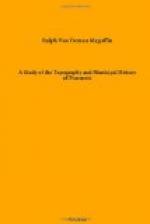There are some other inscriptions not noticed by Delbrueck which mention the aedes,[111] and bear on the question in hand. One inscription found in the Via delle Monache[112] shows that in connection with the sedes Fortunae were a manceps and three cellarii. This is an inscription of the last of the second or the first of the third century A.D.,[113] when both lower and upper temples were in very great favor. It shows further that only the lower temple is meant, for the number is too small to be applicable to the great upper temple, and it also shows that aedes, means the temple building itself and not the whole precinct. There is also an inscription, now in the floor of the cathedral, that mentions aedes. Its provenience is noteworthy.[114] There were other buildings, however, belonging to the precinct of the lower temple, as is shown by the remains today.[115] That there was more than one sacred building is also shown by inscriptions which mention aedes sacrae,[116] though these may refer of course to the upper temple as well.
There are yet two inscriptions of importance, one of which mentions a porticus, the other an aedes et porticus.[117] The second of these inscriptions belongs to a time not much later than the founding of the colony. It tells that certain work was done by decree of the decuriones, and it can hardly refer to the ancient lower temple, but must mean either the upper one, or still another out on the new forum, for there is where the stone is reported to have been found. The first inscription records a work of some consequence done by a woman in remembrance of her husband.[118] There are no remains to show that the forum below the town had any temple of such consequence, so it seems best to refer both these inscriptions to the upper temple, which, as we know, was rich in marble.[119]
Now after having brought together all the usages of the word aedes in its application to the temple of Praeneste, it seems that Delbrueck has very small foundation for his argument which assumes as settled the exact meaning and location of the aedes Fortunae.
From the temple itself we turn now to a brief discussion of a space on the tufa wall which helps to face the cave on the west. This is a smoothed surface which shows a narrow cornice ledge above it, and a narrow base below. In it are a number of irregularly driven holes. Delbrueck calls it a votive niche,[120] and says that the “viele regellos verstreute Nagelloecher” are due to nails upon which votive offerings were suspended.
This seems quite impossible. The holes are much too irregular to have served such a purpose. The holes show positively that they were made by nails which held up a slab of some kind, perhaps of marble, on which were displayed the replies from the goddess[121] which were too long to be given by means of the lettered blocks (sortes). Most likely, however, it was a marble slab or bronze tablet which contained the lex templi, and was something like the tabula Veliterna.[122]




